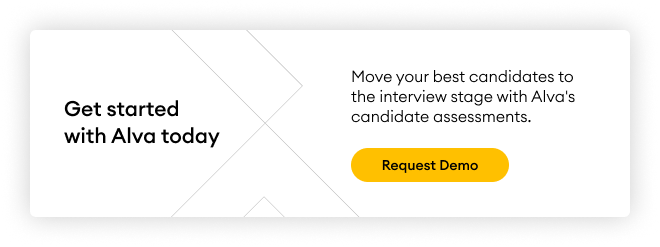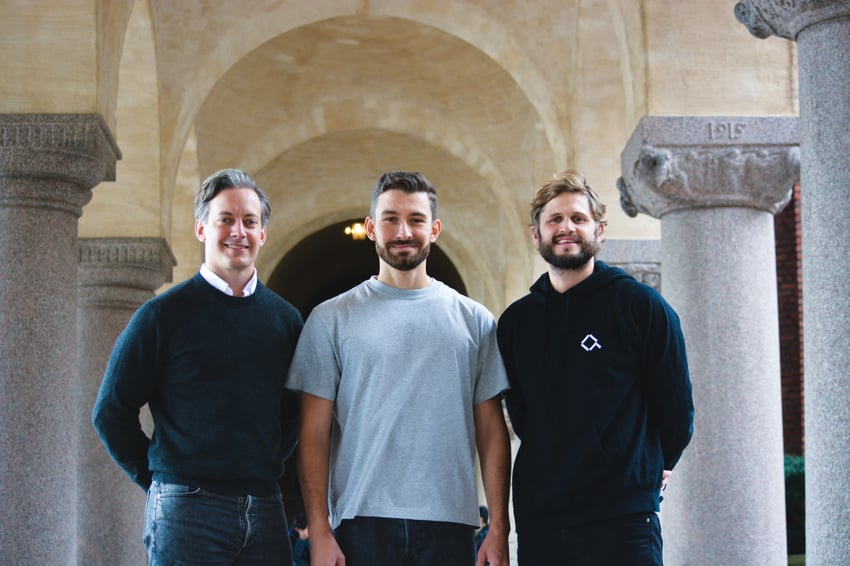The only way to check if a candidate is qualified and job-ready is to test their skills and evaluate their expertise.
But how can you do that with no coding knowledge? Do you have to get developer experts involved in the hiring and help you to evaluate candidates?
There's an easier way.
And it starts with our in-depth guide on hiring exceptional software engineers! With specially curated insights from our in-house engineering experts and tech recruitment specialists, learn everything there is to know about hiring only the best developers for your team.
The hiring challenge
The clock is ticking, and you're in the interview room with a software engineering candidate. Time is slipping away, and your decision is high-stakes. Should you hire the person in front of you?
You decide to follow your hunch and hire the engineer. After all-they can code in your language and fit the technical requirements of what you're after.
Fast forward a few months, and your new hire can't keep up with the momentum. Worse, they're rigid in their ways, struggle to pick up tasks quickly and are slow to fix bugs.
Unfortunately, this is a common occurrence in the hiring world-with hiring engineering talent no different.
An added challenge in this context is that many hiring teams tend to heavily prioritise a candidate's technical skills without accounting for their soft skills, like their ability to think outside the box, innovate, and collaborate in a team. These vital skills can be just as crucial at determining whether the candidate will thrive in the role, yet they are often overlooked in the vetting process.
The result? Bad hires typically cost organisations anywhere from $14,900 plus in wasted money, time and resources. In short, mis-hiring someone can have huge financial consequences for a company, making it all the more important to try and get that hire right.
So how can you overcome these challenges as a recruiter? It starts with having a highly effective screening process in place, one that filters out unqualified candidates and simultaneously captures a broad talent pool. It also boils down to having a meticulous, data-driven recruitment process, one that effectively assesses developer talent.
Step-by-step to hiring great software engineers
#1 Widen your talent pool
Increasingly, there is a shortage of suitable candidates on the market, with companies struggling at an all-time high to find engineering talent. But are companies looking in the wrong places?
Generally speaking, companies tend to be more traditional when looking for engineering talent, targeting the same job boards and directories as the masses. The obvious pitfall here is that the competition is high, and fewer candidates are available. But the hidden gems are out there. It's all about knowing how—and where—to look.
When looking for candidates, try and be creative. Aim for: target groups, specific forums, schools, and coding boot camps to widen the net.
At the same time, when crafting your job description, ask what is a need and what is nice to have. This is a crucial step to facilitating a diverse pool and acquiring candidates from different sources.
When narrowing in on your role requirements, apply common sense. Some skills are critical musts for developers to possess. The more senior the role is, the more experience is needed. By taking the time to do a calibration check with key stakeholders, you can figure out your non-negotiables and what the candidate could effectively learn and pick up along the way.
Tip: If you're concerned about casting the net too wide, add screening questions to your job description. For instance, if you need a senior developer on your team who can manage others, then say so. But if you're hiring for a junior role, does that candidate need to have five years of experience?
#2 Fill your pipeline with high-calibre candidates
A fast and effective way to screen candidates is to use psychometric assessments to test a candidate's potential and logical ability. This helps a lot, especially in software engineering, where the very nature of the job requires soaking up new knowledge and learning all the time.
Coupling this with a broader set of requirements that the candidate should possess—like having a good understanding of systems and coding— can make all the difference in finding the right candidates.
For example, at Alva, we use our own candidate assessment platform to broaden our talent pool, minimise hiring bias, and invite the best candidates with the biggest chance of role success for interviews.
How it works: The logic reasoning and personality assessments test a range of factors like logical ability, conscientiousness, extraversion, and emotional ability needed for a candidate to excel in a job role. The assessments take less than 30 minutes to complete; the candidate owns the results, and the recruiter can see which candidates best match the requirements and decide with confidence who to interview.
If you opt for psychometric assessments, we recommend using them as the first step in your hiring process for maximum impact.
#3 Run structured interviews
Rather than free-styling an interview and leading with your gut, a structured interview lets you effectively assess how well a candidate is likely to perform in the role. In other words, structured interviews are one of the best predictors of job performance.
With structured interviews, you ask candidates the same set of questions and measure their responses using a baseline, which is checked against pre-decided criteria. Like this, you minimise bias when picking a candidate and increase the likelihood of making an accurate hire based on these data-fuelled insights.
The first interview should always be with the HR manager or talent acquisition lead. The interview should focus on the candidate's experience level, interpersonal skills and abilities to interact in a team setting and deal with challenges. By focusing on past experience, you start to get an idea of how well the candidate could perform in the future.
The second interview should involve the hiring manager, where you dive deeper into the candidate's technical skills and competencies directly related to the job role.
#4 Meet and greet
The best way to show the candidate what it's like to work at the company is by pairing them with someone from the team for a quick chat. This is a good way for the candidate to get a flavour of the company culture and team environment and give them an open platform to ask questions confidentially.
Tip: Don't make this a necessary step, but rather a voluntary option for the candidate to take this opportunity. It also sends the message that you care about the candidate's experience!
#5 Real-world coding tests
An effective way to evaluate a candidate's technical acumen is to introduce take-home assignments and pair programming exercises. Using third-party tools like Alva's Coding Tests can also help you save time piecing together an assignment.
But what happens if you don't ask for a specific coding language as part of the job requirement. How would you then assess the candidate?
The truth is, learning a new language, technology or design pattern can be picked up relatively quickly if a developer is good. Therefore, the candidate's technical prowess, understanding, problem-solving, and creative thinking are equally important to consider when assessing a candidate.
For instance, Alva uses Python, with candidates required to test in Python. But some engineers who joined us weren't initially well-versed in python. They still went through the hiring process, because we were assessing their complete package—including how skilled of a programmer they were at the recruitment stage.
This is why having a semi-simple assignment that a developer can learn pretty quickly is key.
#6 System-design interview
The last step of the screening process is a system-design interview. The hiring manager usually runs this, where they sit down with the candidate and get the candidate to design a system. They should talk about what they've done and how they've approached the design.
The purpose is to dive deep into the candidate's technical skills, architecture, and communication skills. This complements coding tests pretty well because, in addition to seeing if they can code, you're looking into whether they can build a system and architecture it.
#7 Close the candidate
Congratulations, you've reached the last step of the hiring process- the offer. This is not the time to drop the ball and leave the candidate hanging. Templatising your offers ensures you quickly send the offer without having to manually put together an agreement.
Also, check in with the candidate and let them know exactly what to expect, including key timelines they should be aware of. This ensures you keep the candidate warm throughout, safeguarding their interest in the position.
Why picking the right coding test is a game changer
Most organisations know the value of coding tests, but what makes a tech assessment reliable? What should teams focus on to ensure a good coding test? You must go back to the beginning to get the most value out of this step.
Why are you hiring for this role? What will the engineer help you solve? What qualities will they need to succeed?
For example, say you need to hire a backend engineer. They will most likely benefit from a project-based assignment, one that requires them to build a server. Here, you should pay attention to how they fulfill the specifications of what they need to build. Can they solve the problem?
Next, evaluate how well they solved it. A solid backend engineer in this case, would be able to build a server that doesn't lose data and can handle the increased load.
Tip: A standardised and straightforward coding test is key here because it reduces unconscious bias and helps hiring teams focus on the criteria that truly matter.
Next, pick a reliable and relatively easy-to-use provider. Ideally, you want an easy tool that automates the sending, test completing, and feedback loop. By getting the code reviewed quickly and closing the feedback loop, you will effectively reduce your time to hire.
Conclusion
Unfortunately, there are no shortcuts or "quick miracles" around hiring software engineers. Work has to be done to ensure you get the best possible candidate for the job. If each step is well-optimised and tested, and the whole hiring process works like a well-oiled machine, then your chances of finding the best candidate for the job increase.
The challenge is to structure your process so you can move fast and optimise without discounting the candidate experience or the quality of hire. But once you do that, you will find that hidden gem that will carry your engineering team to the next level.
Assess developer talent with Alva's coding tests
Quickly qualify, shortlist, and interview the best developer candidates with Alva's coding tests.
With Alva's coding tests:
- Assess developers with problems they face in real life
- Keep track of candidates' coding abilities with detailed code review scorecards
- Out-of-box support for most modern programming languages and tech stacks








